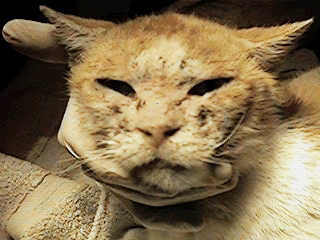Mange
Mange:
A
disease caused by the presence of parasitic mites barely visible to the naked
eye. There are several varieties of parasitic mites, each attacking different
sections of the body. Otodectes cynotis live in the ear canal, causing dark wax
which in turn itches the cat persistently. Notoedres cati are mites that localize
on the head by burrowing beneath the skin, causing itching and loss of hair. Trombiculid
mites (chiggers) can land on any part of the body. They are red, orange, or yellowish
specks no bigger than the point of a pin. They cause severe itching. All mites
must be treated by a vet with a form of insecticide formulated for cats plus a
topical treatment for relief of the symptoms.

Notoedric
mange (Feline Scabies) 
Notoedric
mange is the scabby, scaley, skin disease resulting from infection by the feline
mite Notoedres cati. Notoedres mites are closely related to Sarcoptic mange mites
of dogs and thus the two infections have some similarity. Both conditions typically
begin with itchy crusts and scales an the ear margins. Notoedric mange progresses
to involve the face and ultimately, if the skin disease is ignored, it will cover
the cat’s entire body. The term “scabies” is somewhat colloquial
and refers to a mite infection with any of the mites in Sarcoptidae family. In
the United States, this infection is considered rare with regional “hot beds”
of infection. Many veterinary dermatologists never see this condition in their
entire careers. The Southern California area, however, is such a hot bed and here
the infection is very common. Our practice sees at least one case of Notoedric
mange each month. How
is diagnosis confirmed? A scraping of the crusty skin can
be examined under the microscope. Mites and/or their eggs are generally not difficult
to detect if they are present; still, their absence does not rule Notoedric mange
out. Sometimes a trial course of treatment is needed to fully rule out the infection.
The presence of the mite is highly inflammatory, hence the intense itching. Can
the infection be transmitted to other pets or to humans? Yes, it can. Notoedres
mites are spread by touch and they can certainly infection humans, dogs, or even
rabbits. They do not live off their host for more than a few days at best thus
transmission is generally by direct contact with an infected individual. Treatment There
are several options for the treatment of this condition. DIPPING –In
the past a series of 6 or 7 lime sulfur baths or Amitraz (mitaban®) dips were
used to control this infection. This certainly works but the cat’s general
dislike of bathing had created need for a more convenient treatment. Further,
lime sulfur has an extremely objectionable smell and will discolor fur. Amitraz
tends to produce sedation in some patients and headaches in some humans. IVERMECTIN
– This medication, which is usually given as an injection, has become the
most common treatment due to its convenience and efficacy. Treatment is typically
weekly or every 2 weeks for a month and recovery is prompt. One must consider
though, that the cat may become reinfected if other cats in the household are
infected but not yet showing symptoms or if the cat is an outdoor cat and likely
to again associate with the infected individual who transmitted the infection
to him in the first place. SELAMECTIN (Revolution®) – This topical
medication was designed for flea, heartworm, and intestinal parasite control.
In the dog, it is approved for control of Sarcoptic mange mites but due to the
rarity of Notoedres cati infection, Pfizer is unlikely to pursue the expensive
process of gaining FDA approval for this condition. Still, selamectin, still a
relatively new product, seems to be effective. This product appears to be most
beneficial in prevention of future infections (it is meant to be used monthly
on an indefinite basis for flea control) and provides a convenient means to treat
other housemate cats. It is important to consider that
when one cat at home is diagnosed
with this condition, all cats at home may
require treatment.

| 
